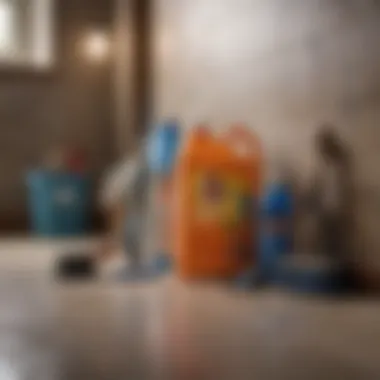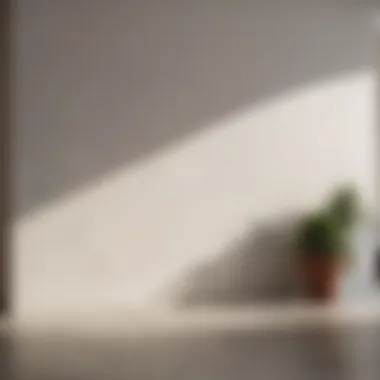A Comprehensive Guide to Cleaning Walls in Your Home


Intro
Cleaning walls may seem like a straightforward task, but it's often overlooked in household upkeep. Many homeowners focus primarily on surfaces that are more visible or easier to access, neglecting the walls that frame their living spaces. This article aims to uncover the best methods and materials useful for cleaning walls in residential environments. Homeowners can benefit from understanding various wall types, as different surfaces require tailored cleaning techniques.
A clean wall contributes not just to visual appeal, but also affects the overall ambiance of a room. Whether you are preparing for a gathering, sprucing up for a season change, or simply maintaining your dwelling, knowing how to effectively clean your walls enhances the aesthetic and functional attributes of your home.
Design Inspirations
Exploring ways to improve interior design can be exciting, especially in relation to wall cleanliness. Clean and well-maintained walls serve as a blank canvas for creativity.
Trending Styles
Currently, minimalistic and neutral-style design trends are popular among homeowners. Clean walls, without stains or marks, complement this look perfectly. The Scandinavian and Japandi styles are notable for their emphasis on simplicity and cleanliness, which relies heavily on wall maintenance. For those leaning towards a bolder statement, using textured paint or wallpaper can add depth. Keeping such walls pristine requires specific cleaning methods to maintain their charm.
Color Palettes
Selecting an appropriate color palette directly relates to wall upkeep. Lighter hues often show dirt and marks more readily compared to darker tones, which may hide imperfections better. Matte finishes can appear elegant but may require more frequent cleaning. Conversely, semi-gloss paints are easier to wipe down. Homeowners should be strategic in their color choices, aligning them with their cleaning routines. For instance, pairing a warm beige wall with slightly darker accents encourages a cohesive look while reducing visible maintenance issues.
Maintenance and Upkeep
Regular maintenance of walls is critical in ensuring longevity and beauty. Homeowners often overlook this aspect, but having a clear strategy helps.
Seasonal Maintenance Checklist
- Inspect for holes and cracks.
- Clean baseboards and corners.
- Dust walls monthly to avoid build-up.
- Check for mold, particularly in humid areas.
- Plan for repainting every few years to refresh look.
Cleaning and Organization Tips
- Use gentle cleaners for delicate surfaces.
- Consider using microfiber cloths to avoid scratches.
- Always test a small area before applying cleaning solution widely.
- Organize cleaning materials in a specific space, so they are accessible when needed.
Maintaining clean walls not only preserves the integrity of your home but also enhances its overall aesthetic, creating a space that feels inviting and well cared for.
In summary, understanding how to clean walls effectively leads to a better living environment. This knowledge also empowers homeowners to enhance their home's interior design, aligning their cleaning habits with their aesthetic goals.
Intro to Wall Cleaning
Clean walls contribute to the overall aesthetic of any home, making the introduction to wall cleaning an essential topic. Maintaining the cleanliness of your walls not only enhances the visual appeal of your living spaces but also ensures a healthy environment. Over time, dirt, dust, and stains can accumulate, leading to an uninviting atmosphere. Therefore, understanding how to properly care for your walls is important for preserving the integrity of the paint and materials.
Understanding the Importance of Clean Walls
Clean walls are often overlooked when it comes to home maintenance. However, they play a significant role in the impression your home creates. Dust and finger marks on walls can diminish the brightness of a room, making it feel neglected. Moreover, maintaining clean walls can prevent structural issues like mold growth, especially in areas with high humidity.
Regular cleaning can extend the lifespan of your wall finishes, saving money on potential repainting or repairs. It is essential for homeowners to recognize that their walls require attention just like any other part of the home.
"A clean, well-maintained wall can turn an ordinary room into a welcoming space."
Types of Wall Finishes and Their Maintenance
Walls can have various finishes which determine their maintenance needs. Common types include paint, wallpaper, and textured surfaces. Each finish requires distinct care methods.
- Painted Walls: With the right cleaning solutions, they are relatively easy to maintain. Regular dusting and occasional washing can keep them looking fresh.
- Wallpapered Surfaces: These require gentle cleaning to avoid damage. It’s crucial to know what type of wallpaper is used, as some can be wiped clean while others may need specialized cleaner.
- Textured Walls: Cleaning them can be more challenging. They tend to trap dust more easily, requiring more frequent upkeep.
- Plaster and Drywall: These surfaces are susceptible to marks and stains, so immediate attention is recommended when spills occur.


By understanding the different types of finishes and their requirements, homeowners can develop effective cleaning strategies tailored to their specific walls.
Preparation for Cleaning
Preparing for wall cleaning is essential for achieving optimal results. Without proper preparation, you may encounter challenges that could hinder your efforts. This stage helps in understanding what needs to be done before the actual cleaning begins. Clean walls not only enhance the overall aesthetic of your home but also contribute to a healthier living environment.
Effective preparation can prevent damage to wall finishes and ensure safety during the cleaning process. Thus, it is vital to gather the right tools, materials, and knowledge before proceeding to the actual cleaning techniques.
Gathering Necessary Tools and Materials
Before beginning the task of cleaning your walls, it's wise to assemble the necessary tools and materials. Having the right items on hand can make the process smoother and more efficient. Important tools for wall cleaning include:
- Soft bristle brush: Useful for removing dust and cobwebs without scratching the surface.
- Microfiber cloths: These cloths are effective for wiping down surfaces, ensuring effectiveness without streaking.
- Buckets: A clean bucket is needed for mixing solutions and rinsing cloths.
- Sponges: They help in applying cleaning solutions evenly on the walls.
- Ladder: If your walls are tall, a sturdy ladder is necessary to reach higher areas safely.
Further, include cleaning solutions that are safe for your specific wall type. This could range from simple soap and water for painted walls to specialized cleaners for wallpaper or textured surfaces. Always refer to manufacturer guidelines when selecting cleaning agents to avoid damaging your walls.
Safety Precautions to Consider
Safety is a critical aspect when preparing for wall cleaning. Certain precautions should never be overlooked. Here are some important considerations:
- Ventilation: Ensure that the area is well-ventilated, especially if using chemical cleaners. Open windows and doors to allow fresh air in.
- Protective Gear: Wear gloves to protect your skin from harsh chemicals. Depending on the cleaner, consider using a mask to avoid inhaling fumes.
- Stabilize Your Ladder: If you are using a ladder, make sure it is stable and on a flat surface to prevent accidents.
- Remove Obstructions: Clear the area around the walls of furniture and decor to avoid any accidents or damage during the cleaning.
Careful attention to these factors will not only enhance your cleaning efficiency but also safeguard your health and surroundings. Always proceed with caution, making informed decisions to ensure a successful cleaning experience.
"Preparedness is the key to efficiency. Taking the time to prepare your environment and tools can significantly impact the outcome of your efforts."
By focusing on these preparatory steps, homeowners can enhance their cleaning sessions, ultimately leading to walls that look refreshed and well-maintained.
Different Wall Types and Their Cleaning Methods
Understanding the differing wall types in homes is crucial for effective cleaning. Each type demands specific cleaning methods and tools. By recognizing the wall finish, homeowners can avoid damage and ensure lasting beauty.
Cleaning Painted Walls
Painted walls are common in many homes. Their maintenance can be straightforward. Start by dusting with a microfiber cloth or duster. This removes loose particles that can scratch when wet cleaning. For washing, prepare a solution of mild soap and water. Use a soft sponge or cloth to gently scrub the surface, working from top to bottom. Be careful not to soak the walls. Rinse the sponge frequently to avoid leaving streaks.
Pro Tip: Always test a small, inconspicuous area before applying any solution broadly to ensure it doesn’t damage the paint.
Approaches for Wallpapered Surfaces
Wallpaper can add visual interest but requires careful handling. Begin by identifying the wallpaper type. Vinyl wallpapers are usually washable, while paper types require more caution. A gentle cleaning solution can be applied to vinyl with a damp cloth. Avoid excessive water to prevent peeling. Non-washable wallpaper should be dusted with a dry cloth only.
Important: Seek guidance specific to your wallpaper type to avoid ruining it.
Caring for Textured Walls
Textured walls can trap dirt and dust in their crevices, making them challenging to clean. A soft bristle brush or vacuum attachment is effective for dust removal. For deeper cleaning, use a gentle cleaning solution on a cloth or sponge. Move in circular motions to avoid missing spots. It's essential to be gentle, as scrubbing too hard can damage the texture.
Note: Regular maintenance can reduce the need for deep cleaning and keep the texture intact.
Methods for Cleaning Plaster and Drywall
Plaster and drywall surfaces are sensitive to moisture. Start by dry dusting these surfaces with a soft broom or microfiber cloth. For stains, a damp cloth with a bit of soap can work wonders. Apply carefully to avoid water damage. Use a minimal amount of liquid and dry the area promptly after cleaning.


Reminder: Always consider the condition of the plaster or drywall. Repair any cracks before extensive cleaning to maintain integrity.
Step-by-Step Cleaning Procedures
Cleaning walls is not just a chore but an essential part of home maintenance that ensures a healthy and aesthetically pleasing environment. Implementing systematic step-by-step procedures simplifies the task and makes it more efficient. These procedures help homeowners tackle wall cleaning with confidence, ensuring no part is overlooked while minimizing potential damage to the surfaces.
Preparing the Cleaning Solution
The first step in any wall cleaning task is to prepare an effective cleaning solution. The choice of solution will depend on the type of wall and the level of dirt or stains present. For example, a mixture of warm water and dish soap is often effective for painted walls. For tougher stains, adding a small amount of white vinegar can enhance the solution’s cleaning power. Here are some steps to consider:
- Assess the Condition: Before preparing the solution, evaluate the wall’s condition. Identify areas that may need special attention.
- Choose the Right Ingredients: Depending on the wall type, gather appropriate materials. For instance, use non-abrasive cleaners on delicate wallpaper.
- Measure Properly: Use a ratio that maximizes cleanliness without risking wall damage. A general guideline is one cup of vinegar for every gallon of water.
Mix these ingredients in a bucket and stir well. Having the solution ready allows for a smoother cleaning process.
Techniques for Dusting Walls
Before any washing occurs, dusting is crucial. Dust can accumulate on walls over time and lead to dull appearances. Proper dusting techniques can prepare the wall for a more thorough clean:
- Use a Microfiber Cloth: This cloth traps dust effectively without scratching the surface. Start at the top of the wall and work downward.
- Employ a Broom or Extension Duster: For higher areas, a broom with a microfiber attachment can help reach higher sections without needing a ladder.
- Dust in Sections: Approach the task methodically. Divide the wall into sections and complete one at a time to ensure comprehensive cleansing.
These dusting efforts will enhance the effectiveness of subsequent washing steps.
Washing Walls: A Detailed Approach
Once the wall is dust-free, washing can begin. This task requires careful execution to prevent damage:
- Apply the Cleaning Solution: Use a sponge or soft cloth dipped in the cleaning solution. Start clearing a small area first to test how the wall reacts.
- Use Gentle Pressure: Avoid scrubbing too hard, which can damage finish or wallpaper. Light, circular motions are often effective.
- Rinse the Sponge Regularly: This ensures that dirt is not redeposited onto the wall as you clean.
- Work from Top to Bottom: This method ensures that any water or solution runs downwards and does not smear clean sections.
Be vigilant in checking your tools. Change your sponge or cloth when it becomes too sullied to perform efficiently.
Drying and Finishing Touches
After washing, allow the wall to dry properly to avoid any moisture-related issues:
- Use Dry Towels: A clean, dry microfiber towel can speed up the drying process. Gently pat the walls instead of rubbing, to help absorb excess water.
- Maintain Ventilation: Open windows or doors while the walls dry to enhance airflow. This can significantly reduce drying time.
- Inspect for Missed Areas: Once the wall is dry, check for spots that might require additional cleaning.
Taking these final steps ensures that the walls not only look clean but also minimize the risk of mold or paint damage. With consistent application of these step-by-step procedures, wall cleaning becomes a manageable, effective task.
Dealing with Stains and Marks
Dealing with stains and marks on walls is an essential aspect of wall maintenance that no homeowner can overlook. Stains not only detract from the overall aesthetics of a space, but they can also signal other underlying issues, such as moisture problems or neglected repairs. Fast and effective stain removal is crucial, as some stains can become more stubborn over time, making them increasingly difficult to eliminate.
Understanding how to identify and address these stains will help maintain the appearance and integrity of your walls, maximize the lifespan of various wall finishes, and ultimately contribute to a healthier living environment.
Identifying Common Stains
To effectively tackle wall stains, first, you must recognize their sources and types. Common stains include:
- Food and Beverage Stains: These often originate from splatters during meal preparation or drinks that tip over. For example, tomato sauce or coffee can leave unsightly marks that require specific cleaning methods.
- Grease Stains: Typically found in kitchens, these stains come from cooking activities. They may be harder to remove because of their oily nature.
- Ink and Marker Stains: Common in homes with children, these stains arise from accidental marks left by pens or magic markers.
- Dirt and Dust Marks: Often a result of hands touching the walls, these stale marks accumulate over time and usually require routine cleaning.
- Mold and Mildew: These biological contaminants thrive in damp or humid conditions. Their presence can not only stain walls but also indicate moisture issues that need addressing immediately.
Recognizing these stains early on can save you significant effort in the long run.
Effective Stain Removal Techniques


Once you've identified the type of stain on your walls, it's time to implement effective removal techniques. Not all stains require the same method, so you should choose appropriately:
- For Food and Beverage Stains: Dampen a clean cloth with mild soap mixed with warm water. Gently wipe the area, followed by a dry cloth to prevent moisture from seeping into the wall.
- For Grease Stains: Mix equal parts of water and white vinegar in a spray bottle. Spray the greasy area and let it sit for a minute before wiping with a clean cloth. Rinse the cloth often during this process to prevent re-contaminating the surface.
- For Ink and Marker Stains: Rubbing alcohol can be effective here. Apply a small amount on a cotton ball and gently blot the stain until it is gone, then wipe with a damp cloth.
- For Dirt and Dust Marks: Using a damp sponge with a bit of dish soap works well. This method not only cleans the stains but also refreshes the wall’s appearance.
- For Mold and Mildew: Use a mixture of hydrogen peroxide and water. Scrub the affected area carefully and dry thoroughly to prevent moisture retention.
Always test any cleaning solution on a hidden area first to ensure it will not damage your wall finish.
How to Prevent Future Stains
After effectively dealing with stains, it’s wise to consider preventive measures. Prevention can save time and effort in the future:
- Use Washable Paints: Opt for high-quality washable paints that allow easy cleaning of stains.
- Clean Regularly: Implement a routine cleaning schedule for the walls using a soft cloth to minimize dust and dirt accumulation.
- Be Mindful While Hosting: When hosting parties or gatherings, take precautions against food and drink spills. Consider using tablecloths and coasters.
- Address Moisture Issues: Install proper ventilation in areas prone to moisture, like bathrooms and kitchens, to prevent mold growth.
- Keep Walls Protected: Use wall protectors or decals in high-traffic areas to minimize direct contact with the wall surface.
By being proactive, you can significantly reduce the occurrences of stains and maintain clean walls effortlessly.
"Preventive measures are often easier and more effective than remediation. Investing time in prevention will pay dividends later."
Through a combination of awareness, effective techniques, and preventive strategies, homeowners can maintain walls that are not only visually appealing but also durable against stains. This careful approach leads to a more pleasant living environment.
Post-Cleaning Maintenance
Post-cleaning maintenance is vital not just for aesthetic purposes but also for the longevity of your walls. Clean walls enhance the overall ambiance of any room, creating a fresh and inviting atmosphere. Maintaining that cleanliness means being attentive to changes over time that may indicate wear and tear. Regular maintenance can save you from costly repairs or extensive cleaning sessions later on.
Recognizing Signs of Wear and Tear
It's crucial to identify signs of wear and tear early. These indicators can manifest in various forms, each requiring attention. Look for:
- Fading Color or Paint: This often happens in high-traffic areas or spaces exposed to sunlight.
- Peeling Paint or Wallpaper: This occurs when moisture seeps behind the surface, often needing immediate action.
- Dirt Accumulation: The presence of dirt, dust, or stains suggests it's time for cleaning again.
- Cracks and Holes: These may indicate structural issues and warrant further inspection, not simply maintenance.
Being proactive about identifying these signs can prevent further deterioration and keep your walls looking their best.
Routine Maintenance Tips
Establishing a routine maintenance plan helps sustain the cleanliness and integrity of your walls. Here are some practical tips:
- Regular Dusting: Use a microfiber cloth or duster to remove dust every few weeks, paying attention to corners and edges.
- Spot Clean: Address stains or marks as they appear to avoid buildup. Use gentle cleaning solutions appropriate for your wall type.
- Use Protective Coatings: Consider applying a sealant for painted surfaces to resist stains and spills.
- Schedule Deep Cleanings: Depending on usage, plan for a more thorough cleaning every six months or at least once a year.
"Maintenance is a continuous process that ensures your walls remain in prime condition."
Incorporating these practices can enhance both the aesthetics and durability of your walls, preserving the investment you have made in your home. Consistency is key in ensuring that your living spaces are not only beautiful but also well-maintained.
The End
In a comprehensive guide about cleaning walls in your home, the conclusion holds significant importance, summarizing the central themes and reinforcing practical approaches to wall maintenance. Clean walls not only enhance the aesthetic appeal of a residence but also contribute to the overall health and wellbeing of its occupants. Regular attention to wall cleanliness can prevent long-term damage and reduce the costs associated with extensive repairs and repainting in the future.
Recapping Key Points
As we conclude, it is essential to revisit the key points discussed throughout this article:
- Understanding Your Walls: Different wall types necessitate unique cleaning methods. Painted, wallpapered, and textured surfaces require tailored approaches for maintenance.
- Preparation is Vital: Gathering tools and safety precautions is essential before initiating cleaning. This should include choosing the right cleaners compatible with wall finishes.
- Effective Cleaning Techniques: Step-by-step processes for washing walls, dusting, and stain removal ensure thoroughness, contributing to cleaner living spaces.
- Post-Cleaning Care: Recognizing signs of wear and maintaining walls routinely can prevent deterioration over time.
By reflecting on these elements, readers can realize the significant benefits that come from regularly cleaning their walls, ensuring both visual appeal and structural integrity.
Encouraging Regular Wall Maintenance
To foster lasting results, it is vital to encourage regular wall maintenance practices among homeowners. Setting a cleaning schedule, even if it is semi-annual, can effectively reduce the build-up of dust, grime, and stains. Here are a few recommendations:
- Establish a Routine: Create a maintenance calendar that includes wall cleaning alongside other household chores. This can help in building a habit and ensuring consistency.
- Utilize the Right Tools: Invest in quality cleaning supplies. Using the appropriate tools for different surfaces can make the task easier and more effective.
- Educate Family Members: Share knowledge about wall care with all household members. Understanding how to handle stains or minor marks can help maintain wall conditions.
Regular wall maintenance is not only about cleanliness but also about extending the life of your home’s interior. By appreciating the significance of this practice, homeowners can create spaces that reflect their values of cleanliness and care.







